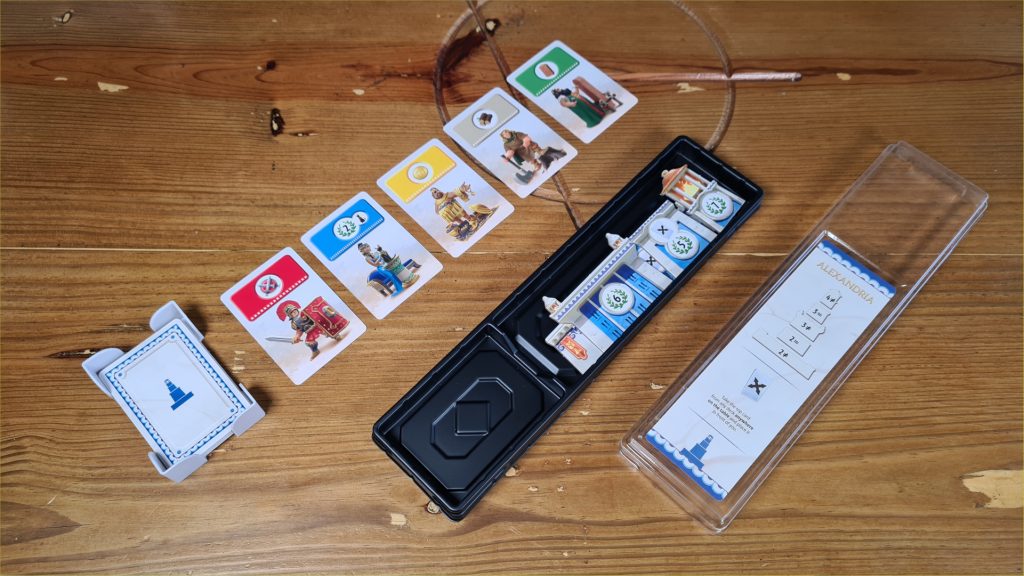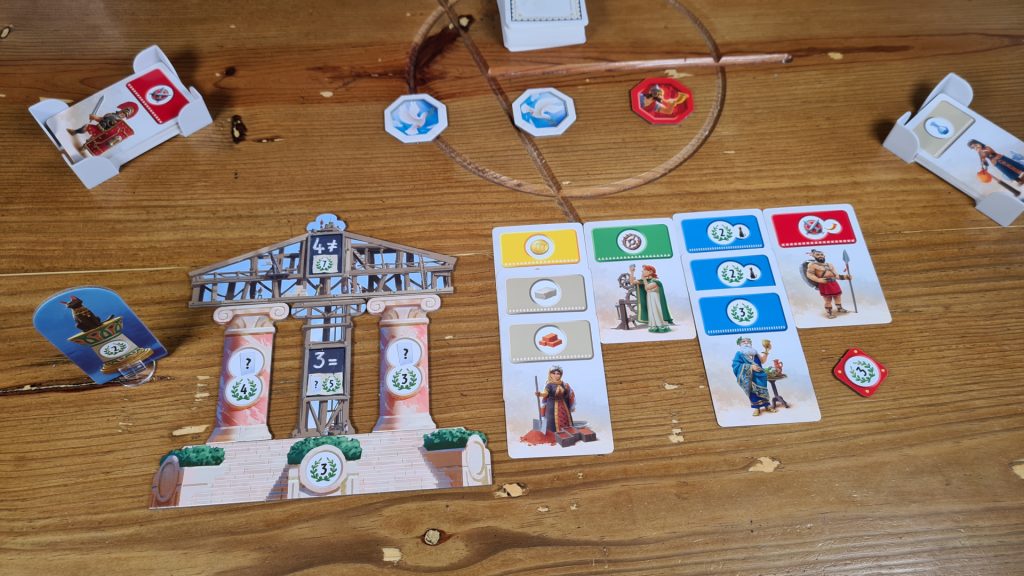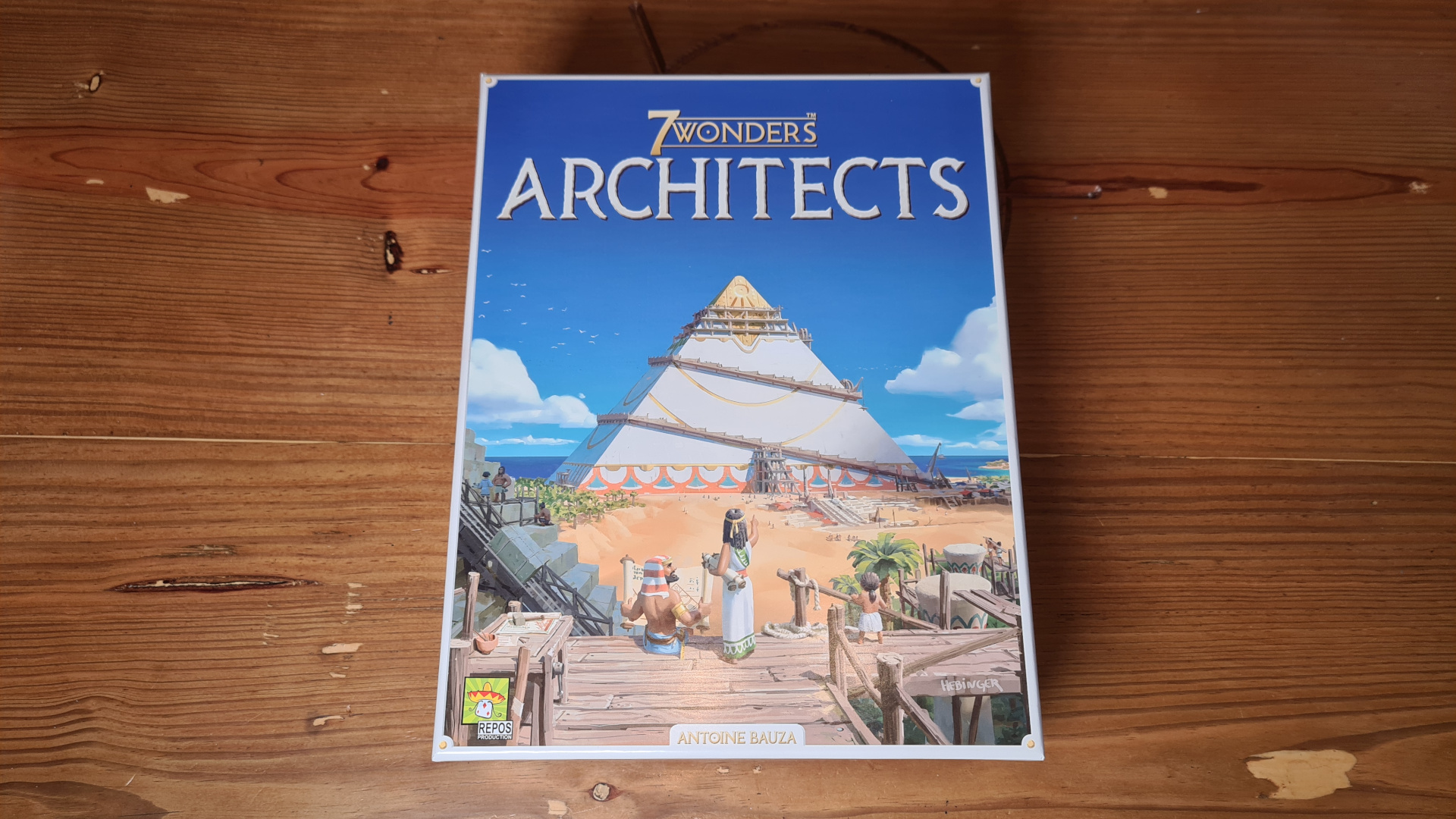7 Wonders Architects is the brand new card drafting and set collection board game from publisher Repos Production. Designed by Antoine Bauza, featuring artwork from Etienne Hebinger, the game is the third in the series – aiming more for a family audience than its predecessors. This time around 2 – 7 players will attempt to construct their wonders, progress through science and battle it out – all in about 20 minutes. However, does this simplify the fun out of the 7 Wonders experience? Let’s find out!
To set up the game there is a very short checklist to work through. Firstly, each player gets a random wonder box, the central deck needs to be shuffled and tokens put within reach. Each player then shuffles their faction’s deck and places it in between themselves and the player to their left. The final stage of setup is each player builds their wonder, alas using the unconstructed side of the pieces.
Unlike the original 7 Wonders in Architects there are no set rounds, nor are there hands of cards to choose from and pass around. Instead, on a turn the active player has a choice between drawing a card from 3 locations. Each player always has access to the facedown deck in the center of the table, and then two face up draw piles between themselves and the players on their left and their right. If one of these piles has run out then that choice is then more limited. After taking a card from one of the three locations play moves on clockwise to the next player.
Cards can be one of 5 types. Resources cards are taken to help the player build their wonder, with no requirements on cards for resources. When a player has the necessary resources, which can be 2 identical resources or perhaps 3 different resource types, these cards are discarded to flip over the wonder section that’s being built. Wonders must be built from the group up, though if two or more sections are on the same level the player can build them in any order. Gold cards are the second type of card and are treated as a wild resource, these are also solely for wonder building.
Blue buildings are, much like in the original, straight victory points for the end of the game – offering either 2 or 3 points. Why you’d ever take a 2 point card is that they also come with a cat symbol, allowing you to claim the cat pawn (from the middle or whomever previously had claimed it). When it’s your turn if you have the cat pawn then you can look at what the top card of the central deck is prior to choosing a card.

Of course it wouldn’t be a 7 Wonders game without military and due to the removal of distinct rounds this is treated slightly differently from before. Based on the player count a number of conflict tokens are added into the middle of the table, peace side up. When a player takes a red military card they place it into their tableau, boosting their strength, and check the card for horn symbols. Coming with 0 – 2 horns, for each horn the player flips over that many peace tokens to the battle side. When all of the tokens are on the battle side, conflict is triggered. Each player compares their military strength, from their cards, tokens and wonder, with their two neighbours. For each neighbour a player has a higher strength than they gain a 3 point military token. The conflict tokens are then all flipped back to the peace side and the game continues.
The final card type is science. These do not score any points though collecting 3 different science symbols or two matching symbols will enable the player to discard them for a progress token. There is always a market of 4 face up progress tokens, each offering a unique ability. From allowing the player to gain a second card on their turn if they choose a military card with at least 1 horn to scoring bonus points at the end of the game per military victory token, these can help players have bigger turns or score more.
All wonders are made of 5 pieces, with each stage needing more matching or different resources, scoring more points the higher up the wonder they go. Most wonders have a couple of sections that also trigger a bonus action when built. These range from drawing 5 cards and getting to claim one for free to claiming a free progress token. These are small bonuses that only that player will be able to trigger during the game.
Play continues around the table until someone completes their wonder. At this point players count up the points earnt from constructed wonder sections, blue buildings, progress tokens, military tokens and if they have the cat pawn. While there isn’t a scoring pad this isn’t a long process, with the winner whoever has scored the most points. Ties are split by constructed wonder sections, otherwise the victory is shared.

Whilst conventional card drafting isn’t an overly complex game mechanic by removing it it has removed both the need to explain the concept to new players and need for distinct rounds. Without rounds the game flows more freely, constantly going around the table – with occasional quick breaks for combat. Just because the drafting is gone doesn’t remove the hate drafting aspect though. If there’s a card that would trigger a military conflict, someone with no military won’t want to take it, so you can leave it at the top of a deck knowing it’ll limit their choices.
Removing resource costs results in a rather clean, minimalist look on the cards. It also means that there is never the frustration of not being able to pay for a card. Combine this with the lack of special abilities on the cards and there are limited symbols for players to learn / remember during play. Putting the progress tokens aside, each player only has their own one special wonder symbol and there is a reminder of what it does on the faction box. For the first game or two players may need to check the rulebook for the progress tokens, though without them the game would lack that opportunity for bigger turns and lose an entire way to score points.
With the way that resource, gold and science cards are spent players don’t end up with an unwieldy looking tableau of cards in front of them at the end of the game. This doesn’t mean that there aren’t different ways to score though. From the cat pawn scoring 2 points, to plenty of points on offer from various progress tokens, players can easily get 30 – 40 points in a game. Regardless of where you come in the player standings you’ll have had a chance to score a chunk of points, with each choice of card working you towards one potential objective.
None of the 7 Wonders franchise have been bad looking or lacking in quality, though 7 Wonders Architects takes the series to possibly its highest point yet. First off there is the insert. Rarely am I impressive with an insert, yet this is a game that benefits from it. Each wonder comes in its own box. To start playing it’s just a case of everyone opening a box and their wonder pieces and cards are there. With a helpful symbol reminder on the front of the box, they just make setup a breeze. Then there are the wonders which are each crafted from 5 pieces. Their unconstructed sides allow them to always be on the table, slowly coming to life as they are built – each adding eye candy to the table.
The 7 Wonders series has always been one where every choice matters. In the original it might be about paying opponents for resources and in Duel it could have been about risking a military instant victory. Despite not having these aspects there is still an importance to taking cards in 7 Wonders Architects; whether it’s going for resources to build wonder stages or charging into science! There aren’t as wide routes to get points, though by removing the rounds, resource management and such it allows the game to hit the table with a different group of gamers – predominately non-gamers and families. It’s fast paced and it captures the fun of building a wonder, so 7 Wonders Architects will be perfect for its target audience.
(Editor’s Note: 7 Wonders Architects was provided to us by Asmodee for the review. It is currently available from local board game stores! Find your local store here.)

